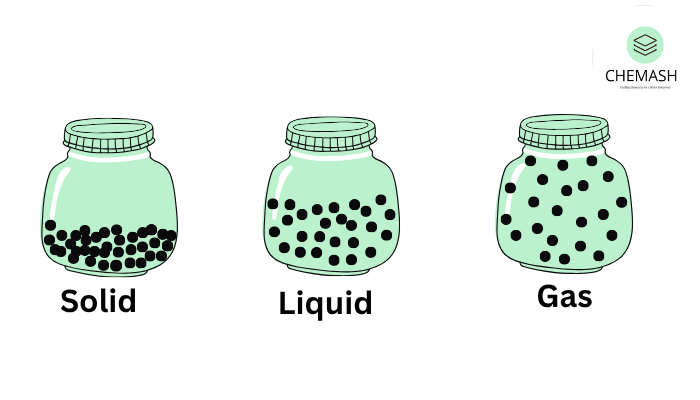
Gaseous State
The gaseous state is one of the primary states of matter. Gases have no fixed shape or volume, are compressible, and expand to fill their containers. Their behaviour is described by several empirical gas laws and theoretical models.
General Characteristics of Gases
- No fixed shape or volume
- Compressible and expandable
- Low density compared to solids/liquids
- Undergo diffusion and effusion
- Particles move randomly at high speeds
Important Terms
- Pressure (P): Force per unit area (units: atm, Pa)
- Volume (V): Space occupied (L or m³)
- Temperature (T): Absolute temperature in Kelvin (K)
- Number of moles (n): Amount of substance
Gas Laws
- Boyle’s Law: At constant T, P ∝ 1/V → PV = constant (e.g., halving V doubles P).
- Charles’ Law: At constant P, V ∝ T → V/T = constant.
- Gay-Lussac’s Law: At constant V, P ∝ T → P/T = constant.
- Avogadro’s Law: V ∝ n → equal volumes contain equal molecules at same T and P.
- Ideal Gas Equation: PV = nRT (R = 8.314 J·mol⁻¹·K⁻¹).
Dalton’s Law of Partial Pressures
The total pressure of a non-reacting gas mixture equals the sum of partial pressures: Ptotal = P1 + P2 + .... Useful for gas collection over water and gas mixtures.
Kinetic Molecular Theory of Gases
- Gases consist of tiny particles in constant random motion.
- Volume of particles is negligible compared to container volume.
- No intermolecular forces (ideal approximation).
- Collisions are perfectly elastic (no energy lost).
- Average kinetic energy ∝ absolute temperature.
Real Gases and Deviations
Real gases deviate from ideal behaviour at high pressures and low temperatures due to intermolecular attractions and finite molecular volume. Van der Waals equation accounts for these:
(P + a n² / V²)(V – n b) = nRT
Quiz: Gaseous State
Short Answer
- What happens to pressure when the volume of a gas is halved at constant temperature?
- Name the gas law which states that volume is directly proportional to temperature.
- What does the ideal gas equation PV = nRT represent?
- When do real gases behave ideally?
- State the unit of pressure in SI system.
Answers & Explanations
- Answer: Pressure doubles. Explanation: Boyle’s law (PV = constant) — halving V doubles P at constant T.
- Answer: Charles’ Law. Explanation: V ∝ T at constant pressure.
- Answer: The ideal gas equation relates pressure, volume, temperature and amount (moles) for an ideal gas; R is the gas constant. Explanation: It combines Boyle, Charles, and Avogadro laws.
- Answer: At low pressure and high temperature. Explanation: Under these conditions intermolecular forces and molecular volumes are negligible.
- Answer: Pascal (Pa). Explanation: SI unit of pressure is N·m⁻², called Pascal.
MCQs
- Which law relates pressure and volume?
a) Charles’ Law b) Boyle’s Law c) Avogadro’s Law d) Gay-Lussac’s Law Explanation: Boyle’s law describes P vs V at constant T. - Which of the following is constant in Charles’ Law?
a) Volume b) Pressure c) Temperature d) Number of moles Explanation: Charles’ law considers constant pressure processes (V ∝ T). - The value of R (gas constant) in SI units is:
a) 8.31 J/K b) 0.082 atm·L·mol⁻¹·K⁻¹ c) 8.314 J·mol⁻¹·K⁻¹ d) 22.4 L Explanation: R = 8.314 J·mol⁻¹·K⁻¹ in SI units. - Real gases deviate from ideal behaviour at:
a) High pressure and low temperature b) Low pressure and high temperature c) High temperature only d) Low pressure only Explanation: High P and low T increase intermolecular effects and non-negligible molecular volume. - Which is not an assumption of kinetic theory of gases?
a) Molecules occupy negligible space b) Molecules attract each other c) Molecules are in constant motion d) Collisions are elastic Explanation: Kinetic theory assumes no intermolecular forces (no attraction).
FAQ
When should I use Van der Waals equation instead of PV = nRT?
Use Van der Waals for gases at high pressures and low temperatures where deviations from ideality become significant.
Why are gases compressible while solids and liquids are not?
Because gas particles are far apart compared to their size; there is a lot of empty space that can be reduced under pressure.
How is partial pressure useful in real-world applications?
Partial pressures are used in calculating gas mixtures (e.g., respiratory physiology, industrial gas blends, and gas collection over water).
Published: September 30, 2025
